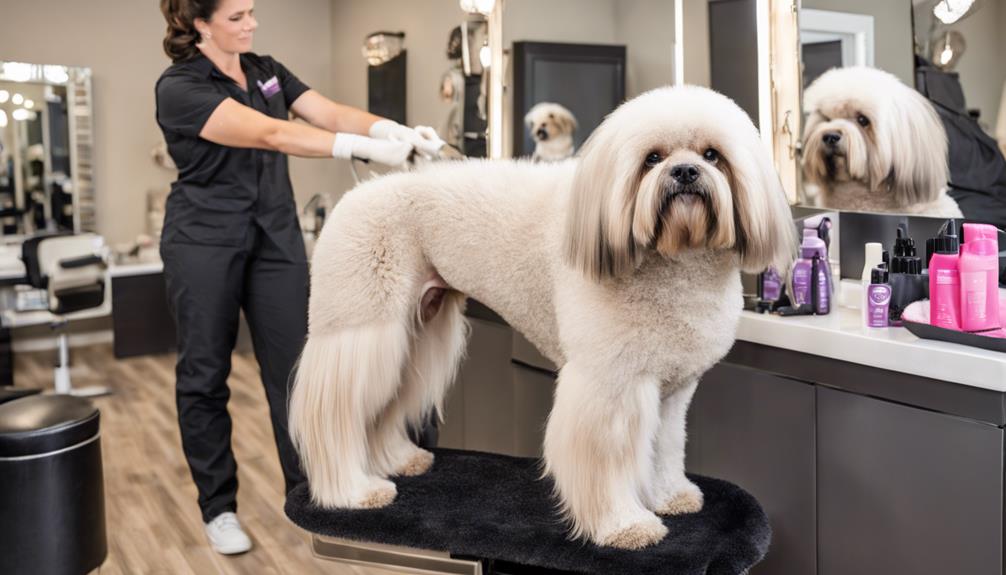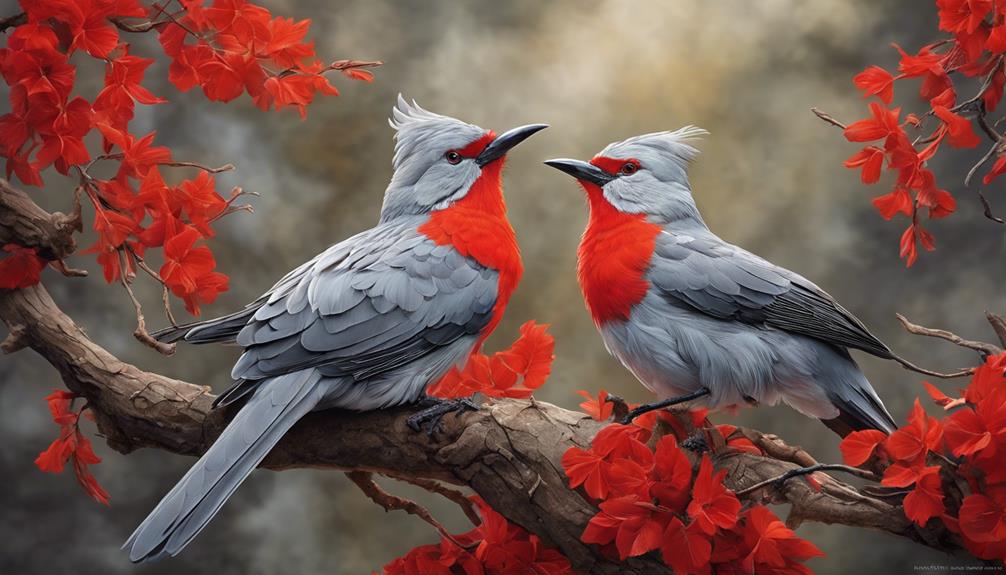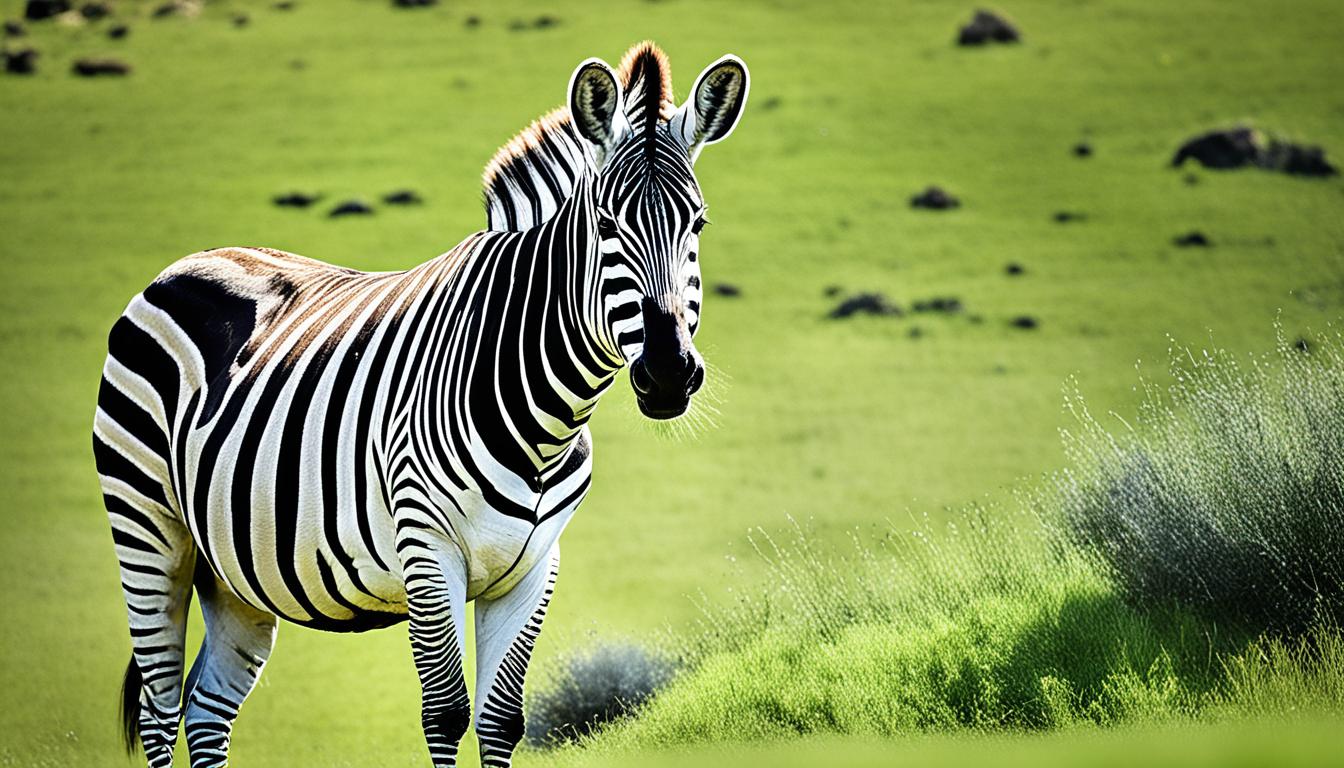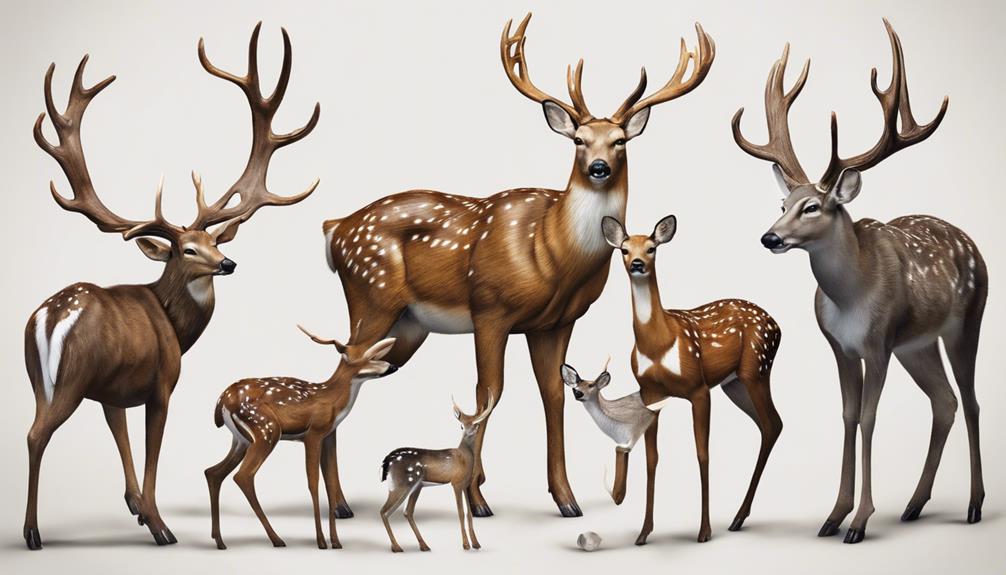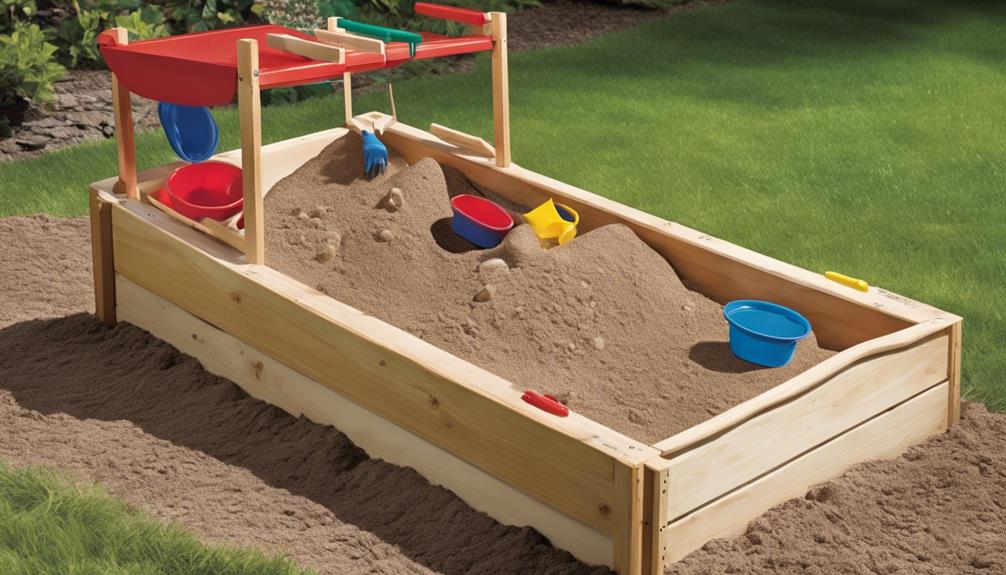Did you realize that nature’s beauty is enhanced by the exceptional beauty of white animals? These mesmerizing creatures, with their flawless coats and otherworldly presence, inspire awe in the wild.
From the frosty Arctic to the dense rainforests, the enchanting allure of white animals dazzles and mesmerizes. As we journey through nature’s tapestry, let us explore the extraordinary world of these magnificent beings.
Key Takeaways:
- White animals possess a unique and captivating beauty that stands out amidst nature’s tapestry.
- The Arctic region is home to majestic white animals such as polar bears, arctic hares, snowy owls, and arctic foxes.
- Aquatic creatures like white dolphins and beluga whales continue to captivate with their elegance.
- South Africa boasts the presence of rare white lions, symbolizing strength and resilience.
- The forests are graced with the elegance of white deer, white squirrels, and other albino animals.
The Majesty of Arctic Wildlife.
The Arctic region is a mesmerizing haven for a variety of majestic white animals. From the expansive icy landscapes to the snow-covered terrain, these creatures embody grace, resilience, and adaptability. Let us explore the awe-inspiring arctic animals that call this frozen wonderland home.
Polar Bears
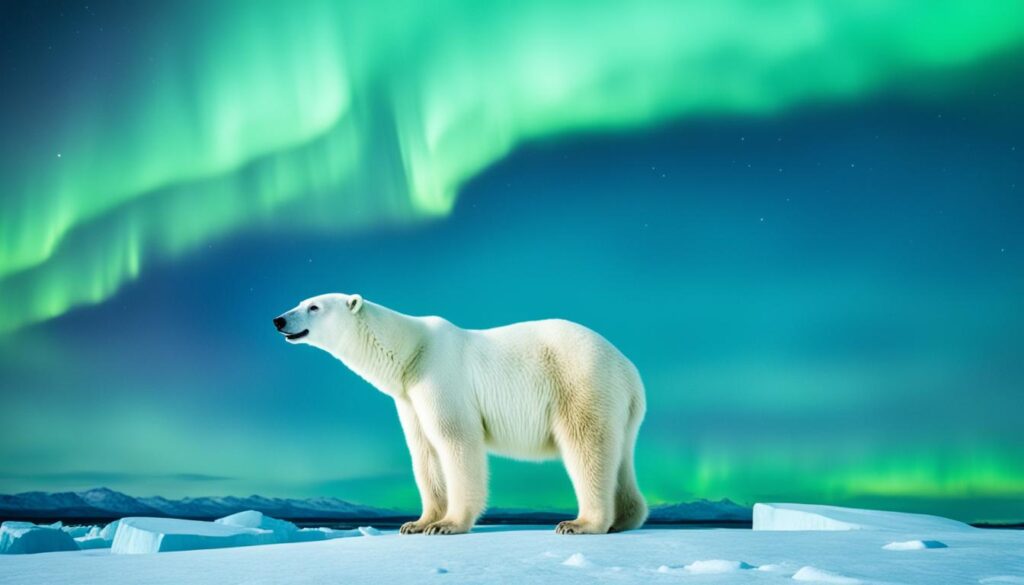
The polar bear, with its thick white fur, is an iconic symbol of the Arctic. This magnificent predator navigates the frozen expanse with power and elegance, showcasing its ability to survive in this harsh environment.
Arctic Hares
The Arctic hares, with their stunning white coats, are the epitome of camouflage in the snowy terrain. Their fur changes color with the seasons, providing them with effective camouflage from predators.
Snowy Owls

The snowy owl, with its striking white plumage, is a sight to behold. These magnificent birds gracefully glide through the frigid skies, their keen eyes scanning the snowy landscapes below.
Arctic Foxes
The elusive arctic fox, dressed in winter white, blends seamlessly into its surroundings. These adaptable creatures have thick fur and fur-covered paws, allowing them to endure the extreme cold and navigate the treacherous Arctic terrain.
The arctic animals of the polar regions captivate our imagination. Their unique adaptations, striking beauty, and ability to thrive in the harsh conditions make them true wonders of nature. Let us continue our journey through nature’s tapestry, exploring the elegance of aquatic creatures in the next section.
The Elegance of Aquatic Creatures.
Under the glistening waves, the beauty of white animals continues to enchant. The white dolphin, also known as the albino dolphin, glides gracefully through the azure waters. With their stunning white skin and captivating presence, they exude an aura of elegance. Another remarkable creature is the beluga whale, often referred to as the “sea canary” due to its melodious songs. These gentle giants, adorned with a striking white color, navigate the Arctic seas with grace.

Whether swimming through the vast oceans or performing acrobatic stunts, white dolphins captivate us with their elegance and beauty. These majestic creatures are a joy to behold, as they leap and dive, their pristine white bodies contrasting against the deep blue sea.
“The elegance and grace of white dolphins inspires a deep sense of wonder and awe. It’s truly a privilege to witness these magnificent creatures in their natural habitat.” – Marine biologist
The beluga whale, with its white skin and playful nature, paints a mesmerizing picture as it traverses the Arctic waters. These charismatic creatures are known for their melodic repertoire, creating a symphony of sounds that echo through the icy expanse. Their stunning white appearance adds to their allure, making encounters with beluga whales an unforgettable experience.
Characteristics of White Dolphins and Beluga Whales
| White Dolphins | Beluga Whales |
|---|---|
| Also known as albino dolphins | Often called “sea canaries” due to their vocalizations |
| Graceful swimmers with acrobatic abilities | Known for their playful nature and ability to mimic human gestures |
| Frequently found in tropical and subtropical waters | Primarily inhabit the Arctic and sub-Arctic regions |
| Feed on a variety of fish and squid | Prey on fish, squid, and other marine invertebrates |
White dolphins and beluga whales are unique aquatic creatures that captivate our imagination and remind us of the remarkable diversity found in the seas. Their elegance and grace serve as a reminder of the breathtaking wonders that await beneath the surface.
The Enigmatic White Lions.
In the heart of South Africa, an awe-inspiring sight awaits. The rare white lions, with their ethereal snowy coats, have captured the fascination of people around the world. These magnificent creatures symbolize strength and resilience, as they adapt to their environment with grace and beauty. Their rarity adds an air of mystery, making encounters with these majestic creatures truly captivating.
Native to the Timbavati region in South Africa, white lions are a genetic rarity caused by a recessive trait known as leucism. Unlike albinism, which results in a complete lack of pigmentation, leucism allows for the partial pigmentation of the skin and eyes, giving white lions their distinct appearance. Their pure white coats, combined with piercing blue or golden eyes, create a mesmerizing sight that is both enchanting and elusive.
Conservation Efforts:
Due to their unique genetic makeup, white lions face numerous challenges in the wild. Their conspicuous coloration makes them vulnerable to predators, and they often struggle to camouflage themselves during hunts. In addition, their rarity has made them a target for trophy hunters and illegal wildlife traders, further endangering their population.
Fortunately, various organizations and conservationists in South Africa are dedicated to protecting and preserving the white lion population. They work tirelessly to conserve their habitats, raise awareness about their plight, and combat practices such as canned hunting and illegal trade. By supporting these efforts, we can help ensure the survival of these beautiful creatures for future generations.
“The white lion is a symbol of the delicate balance between humanity and nature. Their presence reminds us of our responsibility to protect and cherish all living beings.”
Encountering white lions in their natural habitat is a truly remarkable experience. Witnessing these regal creatures roam the African plains evokes a sense of wonder and connection to the wild. It is a testament to the enduring beauty and resilience of nature, reminding us of the intricate tapestry of life.
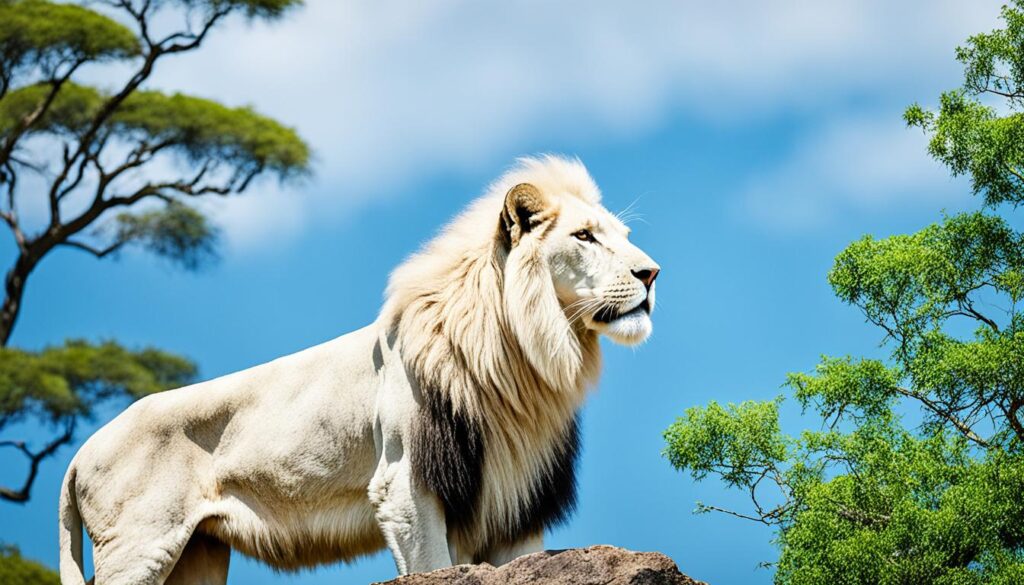
| Characteristics | Habitat | Threats |
|---|---|---|
| Distinct white coat and piercing eyes | Timbavati region of South Africa | Predation, habitat loss, illegal trade |
| Symbol of strength and resilience | Grasslands and savannas | Trophy hunting, canned hunting |
| Rare genetic trait known as leucism | Requires vast territories for hunting | Human-wildlife conflict |
| Elusive and captivating | Dependent on healthy prey populations | Loss of genetic diversity |
The Graceful Albinos of the Forest.
Within the realms of the forest, a realm of enchantment unfolds. White deer, with their purity and grace, roam through the dappled foliage, embodying the tranquility of nature. White squirrels, with their striking appearance and playful demeanor, bring a touch of whimsy to the woodland. Albino animals, whether deer, squirrels, or other forest dwellers, serve as a reminder of the diversity and wonder found in the natural world.
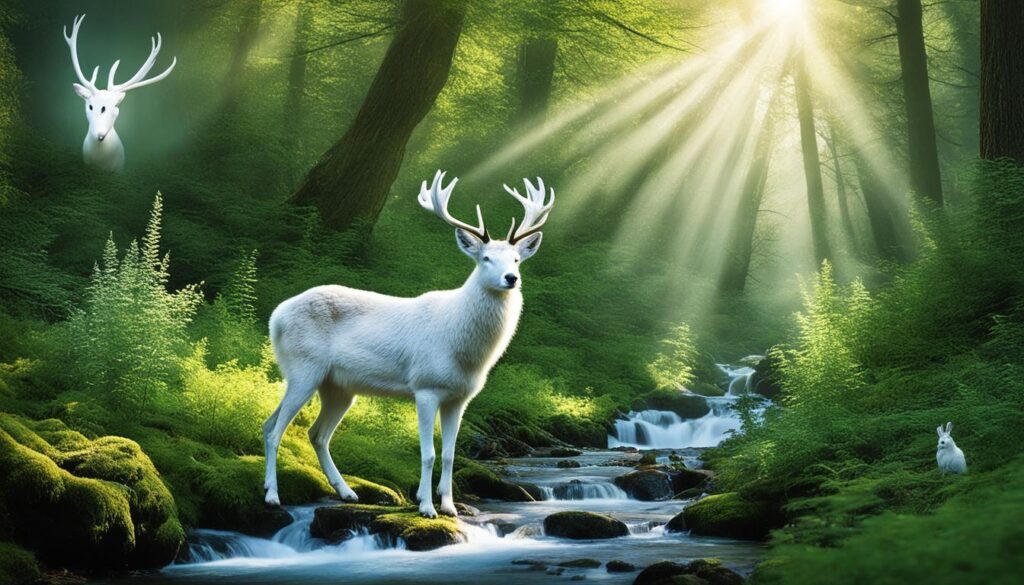
The Elegance of White Deer
White deer, often seen as mystical creatures, evoke a sense of wonder and tranquility as they gracefully move through the forest. Their ethereal appearance, with pure white coats standing out against the green foliage, adds a touch of magic to the natural landscape. These rare and majestic beings captivate our imagination, reminding us of the extraordinary beauty that exists in the wild.
The Playful Whimsy of White Squirrels
Amidst the branches and leaves, white squirrels bring a sense of charm and delight to the forest. Their unique appearance, with bright white fur and radiant eyes, makes them stand out among their fellow squirrels. With their agile movements and mischievous demeanor, these little creatures add a touch of playfulness to the woodland, enchanting both young and old alike.
Albino Animals: Nature’s Extraordinary Creations
Albino animals, including white deer and squirrels, showcase the incredible diversity found in the animal kingdom. Their lack of pigmentation gives them a distinct and captivating appearance, making them truly unique in their environment. Despite facing challenges such as increased visibility to predators or sensitivity to sunlight, these albino animals adapt and thrive, showcasing the resilience and beauty of nature’s creations.
“The presence of white deer and squirrels in the forest reminds us of the delicate balance and captivating wonder of nature.”
By embracing the presence of white deer, white squirrels, and other albino animals, we gain a deeper appreciation for the intricacies and mysteries of the natural world. Their graceful movements and enchanting beauty serve as a reminder that diversity is a gift to be cherished. As we wander through the forest, let us marvel at the tranquil elegance of these albinos, for they are living proof of nature’s ability to create wonders beyond our imagination.
The Symbolic White Peacock.
Amongst the vivid colors of the avian world, the white peacock stands out as a symbol of beauty, grace, and elegance. Its ethereal white plumage, delicately adorned with intricate patterns, mesmerizes all who witness its display. This regal bird embodies purity and transcendence, captivating our hearts and imaginations.
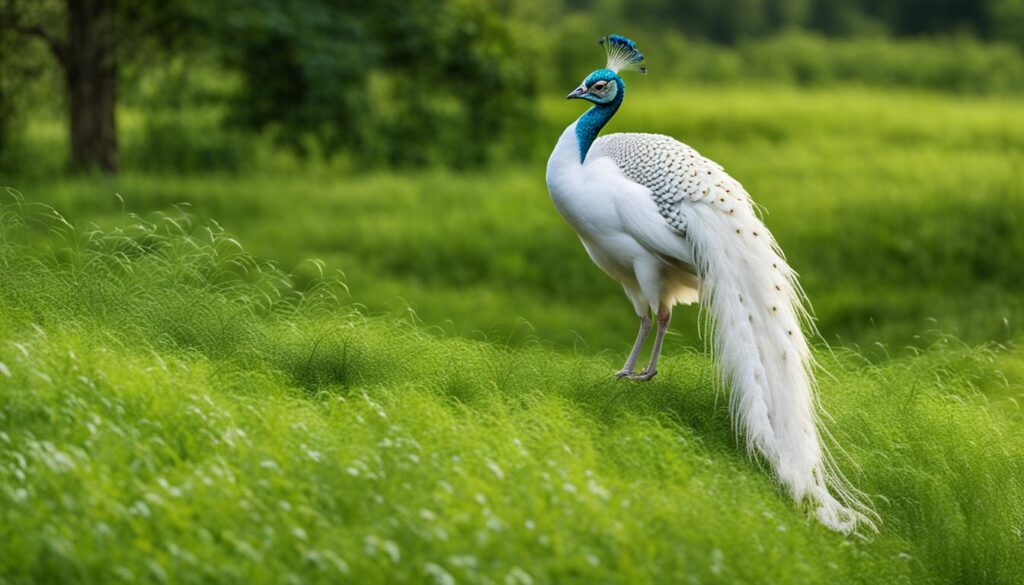
When we think of peacocks, the image of a majestic bird with vibrant, iridescent feathers often comes to mind. However, the white peacock provides a unique variation of this captivating species. Its pure white plumage sets it apart from its colorful counterparts, showcasing a sublime elegance that captures our attention.
While the white peacock lacks the vibrant hues typically associated with peacocks, its ornate patterns make it no less striking. Delicate shades of white, cream, and silver intertwine to create intricate designs on its feathers, resulting in a mesmerizing display fit for royalty.
Throughout history, the white peacock has been revered in various cultures and mythologies. In Greek mythology, the goddess Hera was said to have had a chariot pulled by peacocks, symbolizing her power and regality. The white peacock, with its rare and ethereal beauty, further accentuates these qualities.
“The white peacock, with its exquisite plumage, is a testament to the wonders of nature and the endless possibilities of beauty.”
When encountered in nature or in a sanctuary, the sight of a white peacock gracefully strutting across the landscape leaves a lasting impression. Its ethereal appearance ignites our imagination and reminds us of the enchanting diversity found within the animal kingdom.
As a symbol of beauty, grace, and elegance, the white peacock invites us to appreciate the subtle wonders of the natural world. Its presence serves as a reminder to seek moments of transcendence and to embrace the captivating allure that surrounds us.
The Symbolism of the White Peacock
Throughout various cultures, the white peacock has been associated with different symbolic meanings. In many traditions, it represents:
- Eternity and immortality
- Hope and renewal
- Transcendence and spirituality
- Inner beauty and purity
These interpretations reflect the profound impact the white peacock has on our perception of beauty and the transcendental qualities it embodies.
The White Peacock: A Rare and Captivating Sight
While white peacocks are not as commonly seen as their colorful counterparts, their rarity adds to their allure. Their pristine white plumage makes them stand out amidst their surroundings, captivating onlookers and evoking a sense of wonder and awe.
The intrigue surrounding these magnificent birds extends to their behavior and courtship rituals. Like their colorful counterparts, white peacocks display their feathers to attract and court potential mates. Their magnificent displays showcase a symphony of grace and elegance, further emphasizing their status as symbols of beauty and allure.
Comparison of White Peacock and Colorful Peacock
| Aspect | White Peacock | Colorful Peacock |
|---|---|---|
| Plumage | White with intricate patterns | Colorful and iridescent |
| Symbolism | Beauty, grace, and elegance | Vibrancy, royalty, and pride |
| Rarity | Rare and captivating | More common |
| Behavior | Displayed during courtship rituals | Displayed during courtship and in territorial displays |
The comparison table above highlights the distinguishing features and symbolism of the white peacock in contrast to its colorful counterpart, providing a deeper understanding of their unique qualities.
The Fascination of White Snakes.
Wrapped in mystery, white snakes slither through the shadows, captivating with their otherworldly allure. These rare white snakes, often albino, are a symbol of the unknown, representing both danger and fascination. With their striking white scales and piercing eyes, they serve as a reminder of the serpentine wonders that exist within the natural world.
The Enchanting Beauty of White Snakes
White snakes, also known as albino snakes, possess a unique and captivating beauty that sets them apart from their colorful counterparts. Their snow-white scales glisten in the sunlight, making them a rare and mesmerizing sight to behold. With their serpentine grace and mysterious aura, white snakes hold a deep fascination for both nature enthusiasts and herpetology enthusiasts alike.
“White snakes slither through the shadows, captivating with their otherworldly allure.”
Symbolism and Cultural Significance
White snakes have long been associated with symbolism and cultural significance. In many cultures, they are believed to possess supernatural powers and are often revered as sacred creatures. In certain mythologies, white snakes represent wisdom, transformation, and healing. Their presence in folklore and legends reflects their symbolic importance in various societies throughout history.
Conservation and Protection
Due to their rarity, white snakes are particularly vulnerable to habitat loss and illegal capturing for the exotic pet trade. Conservation efforts play a crucial role in preserving these extraordinary creatures and ensuring their survival in the wild. By raising awareness and implementing protective measures, we can safeguard the future of white snakes and appreciate the beauty they bring to our natural world.
| White Snake Species | Habitat | Conservation Status |
|---|---|---|
| Albino California Kingsnake | California, United States | Least Concern |
| Leucistic Timber Rattlesnake | Eastern United States | Near Threatened |
| Albino Corn Snake | Southeastern United States | Least Concern |
| Leucistic White-lipped Python | New Guinea, Australia | Least Concern |
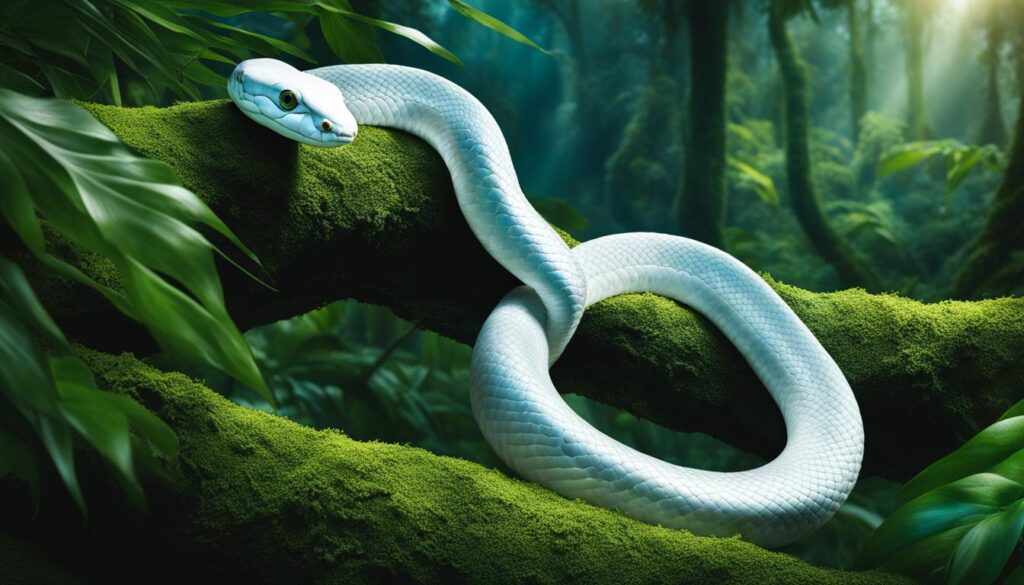
With their allure and symbolism, white snakes continue to captivate our imagination. Let us appreciate their unique beauty and work together to protect these remarkable creatures for generations to come.
The Splendor of White Butterflies.
Fluttering delicately on fragile wings, white butterflies epitomize purity and transformation. These ethereal creatures, clothed in shimmering white, symbolize hope, rebirth, and the ephemeral beauty of life. Their presence brings joy and a sense of wonder as they gracefully dance amidst the flowers, their delicate journey captivating all who observe.
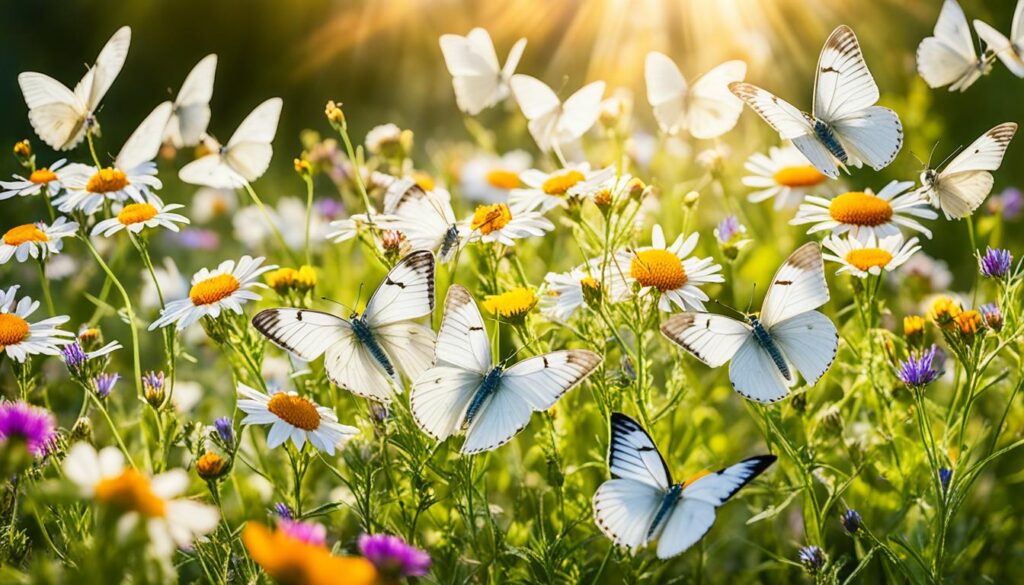
Interesting Facts about White Butterflies:
- White butterflies belong to the family Pieridae.
- The color white in butterflies is caused by the reflection and diffusion of light from their wings.
- White butterflies are often associated with purity, innocence, and spiritual transformation in various cultures.
- They undergo a remarkable metamorphosis, starting as an egg, transforming into a caterpillar, then entering a chrysalis to finally emerge as a beautiful butterfly.
- The white color of their wings serves as a defense mechanism, camouflaging them against predators.
- These graceful insects are known for their ability to migrate over long distances, captivating people with their collective beauty.
“The white butterfly is a symbol of purity and grace, reminding us of the beauty that can arise from humble beginnings.”
Whether they flutter through gardens or meadows, white butterflies bring a touch of enchantment to the natural world. Their delicate presence serves as a reminder of the ever-present potential for transformation. As they dance from flower to flower, these gentle creatures inspire us to embrace the purity within ourselves and embrace the transient beauty that life offers.
The Whimsy of White Rabbits.
In snowy landscapes, a touch of whimsy comes to life with the presence of white rabbits. These magical creatures, with their fluffy white fur and lively hops, evoke a sense of joy and playfulness. They symbolize fertility, abundance, and the promise of new beginnings, turning winter into a season of enchantment.
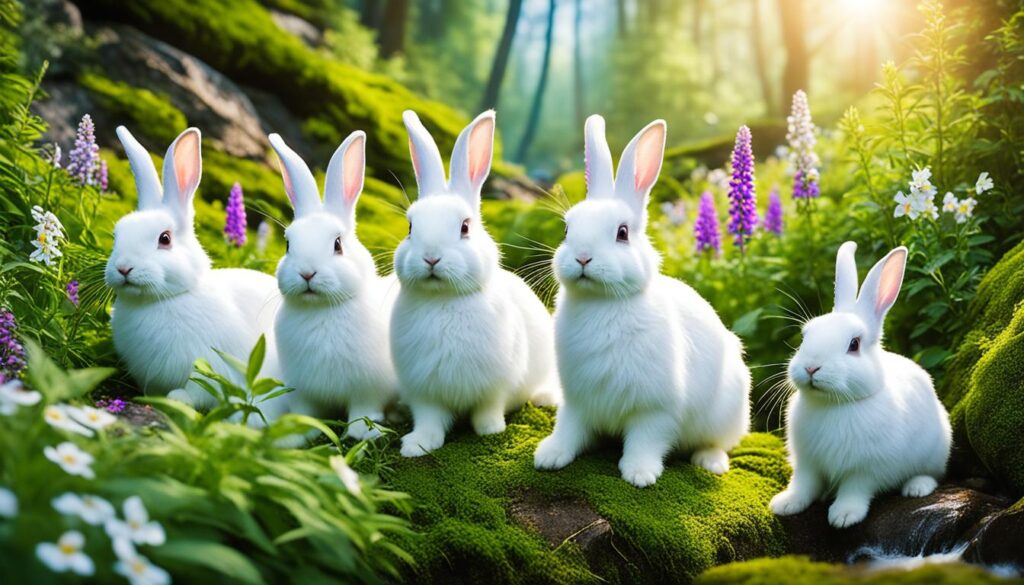
“White rabbits are like little balls of snow bouncing through the meadows. Their playful nature brings a smile to our faces and reminds us of the pure joy that can be found in nature’s hidden corners.”
The Enduring Beauty of White Animals.
The indelible mark left on nature’s canvas by the enduring beauty of white animals is a sight to behold. From the frozen realms of the Arctic to the lush forests and beyond, these captivating creatures embody grace, purity, and resilience. They inspire awe and evoke powerful emotions, serving as a reminder of the wonders that exist within the natural world.
Let us cherish and protect these enchanting beings, recognizing their presence as a testament to the marvels of life. The ethereal white coats of these creatures stand out amongst nature’s diverse tapestry, symbolizing purity and tranquility. Their resilience in adapting to their environments is a true reflection of their strength and beauty.
As we witness the enduring beauty of white animals, we are reminded of the delicate balance and interconnectedness of all living beings. Their existence serves as a poignant reminder to embrace and conserve the precious gifts of nature. Together, let us celebrate the enduring beauty of white animals and ensure that future generations can marvel at their splendor on nature’s canvas.

